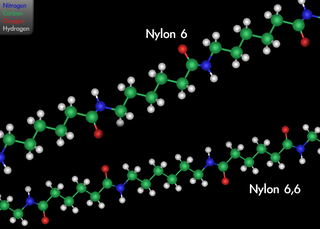Nylon
Appearance
  Nylon 6,6 Nylon 6,6 
| |
|---|---|
| Density | 1.15 g/cm3 |
| Electrical conductivity (σ) | 10−12 S/m |
| Thermal conductivity | 0.25 W/(m·K) |
| Melting point | 463–624 K 190–350 °C 374–663 °F |

Nylon is an artificial fibre. It is one of the most commonly used polyamides, and was first used on February 28, 1935.[1]
Nylon makes a silky material which was first used in toothbrushes. It is strong, hard and water resistant. It is used to make clothes. In fact, polyamides are mostly used for synthetic fibres in clothing. Nylon can also be used to make other materials, such as parachutes, ropes, string for tyres, carpets, fishing nets and cloth and socks.
Nylon was invented by Wallace Carothers at Du-Pont.[2][3]
References
[change | change source]- ↑ Palmer R.J. 2001. Polyamides, plastics. In Encyclopedia of Popolymer science and technology. doi:10.1002/0471440264.pst251
- ↑ American Chemical Society National Historic Chemical Landmarks. "Foundations of Polymer Science: Wallace Hume Carothers and the Development of Nylon". ACS Chemistry for Life. Retrieved 27 January 2015.
- ↑ "Wallace Hume Carothers". Science History Institute. June 2016. Retrieved 20 March 2018.
